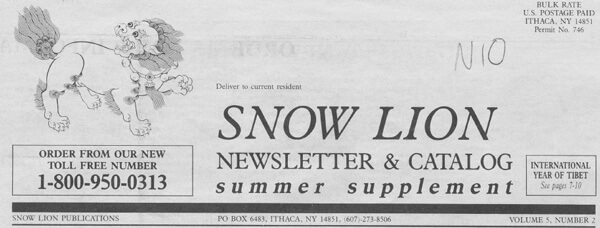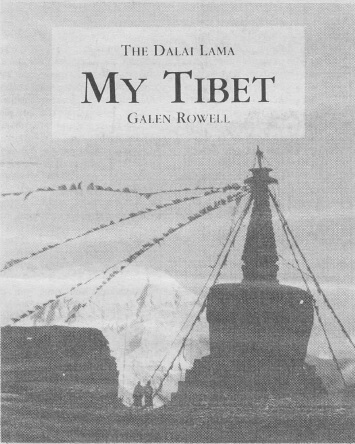| The following article is from the Summer, 1990 issue of the Snow Lion Newsletter and is for historical reference only. You can see this in context of the original newsletter here. |

By H. H. the Dalai Lama & Galen Rowell

In the opinion of the Snow Lion editors, this is one of the most important books to appear on Tibet. The combination of Galen's 108 stunning photographs with the words of His Holiness both describing the scenes and discussing various aspects of Tibetan life make this a truly fabulous book. Here are some selections from the introduction by Galen Rowell. For book information, see catalog section.
The (Dalai Lama's) Five Point Peace Planand the extreme Chinese reaction to itinadvertently set me on the course of doing this book. A few months before His Holiness's proposal, I traveled extensively through Tibet, often giving out photos of the Dalai Lama as gifts to devout Tibetan Buddhists. That same year a friend doing a Tibetan survey with a Chinese forestry official was told by him to bring along photos of the Dalai Lama as gifts to ease relations with the local people. I happened to travel with the same official the following year, 1988, when I returned with Barbara (Rowell) on assignment for the National Geographic magazine.
Meanwhile, the Chinese attitude toward Tibet hardened in the face of demonstrations for independence. The American organization that was helping coordinate my photography in Tibet suggested that we not give out photos of the Dalai Lama in the presence of the mandatory Chinese hosts who would accompany us in the field. I seriously underestimated their reaction when I decided to make an exception at a chance meeting with a nomad who had joined me the previous year on a pilgrimage around sacred Mount Kailas. The Chinese, too, were guests in the nomad's humble tent as I gave out a small, commercially reproduced photo of His Holiness that was readily available for pennies in the Lhasa bazaar. Family members closed their eyes and held the image to their foreheads to receive blessings.
After I returned to America, I was notified that I had been tried in absentia in Beijing and found guilty of sedition. I wrote a carefully worded letter to the Chinese ambassador in Washington, apologizing for any embarrassment I might have caused my hosts, explaining that I in no way thought of my actions as being political. Afterward something inside me snapped. I felt humiliated and ineffectual. Whatever the consequences, I vowed to free myself from the Chinese censorship of the American press that for years has been nearly as effective as China's censorship of its own press. Until recently, American publications have consistently watered down negative stories about China for fear of having their journalistic access cut off.
On further reflection, I became most intrigued by the implied power of that single photograph of the Dalai Lama. Why were the Chinese so threatened? What would happen if I tuned into the positive power of that photo to make it work, not only for me, but also for the future of Tibet? Like notes of a tune I couldn't get out of my head, the dual power of photography and the Dalai Lama spontaneously ran through my thoughts.
The idea for this book came to me just a week later as I began walking a spur of the John Muir Trail in eastern California. The terrain bears an uncanny resemblance to Tibet. Both regions are in the rain shadows of high mountains where open vistas of arid lands rise up to join the snows. Both places have an evolutionary flow that is far more intact than that of neighboring lands. Despite the fact that Tibet has been severely damaged environmentally, it is still better off than most of China, where wild creatures are shot on sight and the first priority of the few nature preserves is to attract foreign currency.
As the appearance of the Sierra and Tibet began to merge in my mind, so did my thoughts about them. I considered the deathly fear the Chinese feel toward the Dalai Lama's possible return to Tibet and the Western world's general skepticism about the reincarnation of the Dalai Lama. In California I was working on both a magazine story about the John Muir Trail and a book to celebrate the 1990 centennial of Yosemite National Park, which would match my photographs with quotations from John Muir. Tibetan Buddhism had already influenced ideas I expressed in the book's introduction. Although Muir died three-quarters of a century ago, he has achieved a considerable measure of immortality in every sense except the physical. His efforts to preserve Yosemite for all time also preserved the environment of his own writings, allowing his words and thoughts to live on today for those who see the same scenes, or for those who see modern photographs of his world. His spirit is still saving wild places today.
It came to me then and there that the Dalai Lama's words could serve the same higher purpose when matched to photographs of Tibet. His voice speaks through the centuries of enduring entities that are threatened, but very much alive, in Tibet today. Although my photographs are my personal vision, and I did not set out on my first trip to Tibet in 1981 with a Buddhist perspective, my pursuit of enduring natural values has led me along a converging path. My original goal there, as in other parts of the world, was simply to follow my own passions and do participatory photography. As much as possible I want to be part of the events I photograph, rather than a spectator. I have never wanted to be a classic journalist who keeps a purposeful emotional distance from his subject matter. Thus to photograph a Tibetan pilgrimage, I became a pilgrim, following the same paths, taking notice of the same auspicious places. To photograph a Tibetan wolf, I became a predator myself, stalking, taking aim, clicking my shutter.

